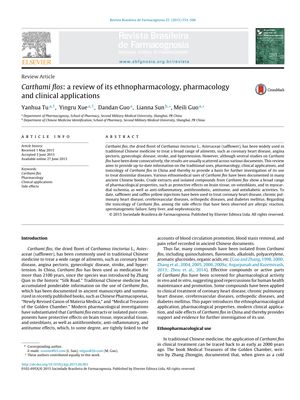Carthami Flos: A Review of Its Ethnopharmacology, Pharmacology, and Clinical Applications
June 2015
in “
Revista Brasileira de Farmacognosia
”

TLDR Safflower has been used in traditional medicine for centuries and shows promise in treating heart, brain, and inflammatory conditions, but more research is needed to ensure its safety.
The document from 2015 provides a comprehensive review of Carthami flos, or safflower, highlighting its traditional use in Chinese medicine for over 2100 years and its pharmacological benefits, including neuroprotective, cardioprotective, antithrombotic, anti-inflammatory, and hepatoprotective effects. Studies have shown that Carthami flos extracts and compounds like Hydroxysafflor yellow A (HSYA) can reduce neurological deficits, myocardial infarction size, and suppress inflammatory responses. It also has potential applications in skin whitening, hair growth promotion, and treatment of various diseases such as coronary heart disease, chronic pulmonary heart disease, cerebrovascular diseases, and diabetes mellitus. Clinical studies, such as those by Sui et al. (2011), have demonstrated its effectiveness in improving survival rates of replanted fingers and preventing postoperative tendon adhesion. However, the document also notes side effects like allergic reactions, reproductive toxicity, and nephrotoxicity, emphasizing the need for further research to understand the mechanisms and ensure the safety of Carthami flos in clinical applications.

